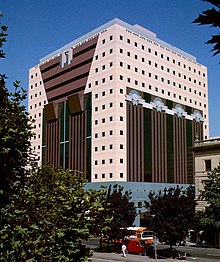Michael Graves
Michael Graves (born July 9, 1934 in Indianapolis , Indiana , † March 12, 2015 in Princeton , New Jersey ) was an American architect and designer .
biography
Graves studied from 1954 at the University of Cincinnati architecture and was four years later Bachelor of Architecture . From 1958 to 1959, Graves completed a master's degree at Harvard . By winning the Prix de Rome at the American Academy in Rome , he was able to complete a postgraduate course in Rome from 1960 to 1962.
On his return to America, he got a job as a lecturer at Princeton University , where he worked as a professor until his death. He has held numerous visiting professorships in Eugene, Oregon , Austin and Houston , among others . In 1964, Graves founded his own architectural practice in Princeton . In the 1970s, Graves was counted among the New York Five , a group of New York architects whose work was summarily proclaimed for a new architectural style at a high-profile conference at MOMA in 1969 .
In 1982 he completed the Portland Building , a new construction for the Portland , Oregon City Council . The building is considered to be the first building of postmodern architecture , which was significantly influenced by Graves.
In 1991 he was accepted into the American Academy of Arts and Letters . In 2001 he was awarded the gold medal of the American Institute of Architects , and in 2012 Michael Graves was elected a member ( NA ) of the National Academy of Design .
After being paralyzed from the chest down due to an infection since 2003, he started designing architecture and equipment that are specifically designed for disabled people. Graves, father of four, last lived and worked in Princeton, where he died on March 12, 2015 at the age of 80.
Projects
Graves was initially known for his designs for magnificent private houses, the ideas he got from Le Corbusier . Its design was based on Cubism in the early 1980s and was characterized by color effects. Graves wanted to structure buildings similar to the human body. He imagined that all buildings should have legs , bodies and heads . To achieve this goal, Graves increasingly focused on tall buildings in his designs.
At the end of the 1980s, Graves made a radical change in style. From now on he breaks away from the strict and clear division of his buildings and uses animal shapes as design elements.
Michael Graves designed a large number of everyday objects, tea kettles, spice mills and dishes as well as armchairs and chairs, but also bathroom furniture and sanitary objects that have become widely known.
Well-known works by Graves are (selection):
- Hanselmann House, Fort Wayne , Indiana (1967–1971)
- Snyderman House, Fort Wayne , Indiana (1972)
- Portland Building , Portland , Oregon (1982)
- Humana Building, Louisville , Kentucky (1985)
- Crown American Building, Johnstown, Pennsylvania (1986)
- Hotel New York, Disneyland Resort Paris , France (1989)
- Denver Public Library, Denver , Colorado 1990
- NTT Headquarters, Tokyo , Japan (1991)
- Marne-la-Vallée , France (1992)
- National Museum of Prehistoric Culture of Taiwan , Taitung , Taiwan (2002)
- Ministerie van Volksgezondheid, Welzijn en Sport, The Hague (2003)
- Minneapolis Institute of Arts , Minneapolis (2006)
- Louwman Museum , The Hague (2010)
- Trump International Hotel & Tower Fort Lauderdale, Fort Lauderdale , Florida (under construction)
literature
- Munzinger, Ludwig: The Munzinger Archive Biographies , Munzinger Archive GmbH 2001
- Nichols, Karen: Michael Graves Buildings and Projects: 1995–2003 , English edition, 2004, ISBN 0-8478-2569-8
Web links
- Literature by and about Michael Graves in the catalog of the German National Library
- Website by Michael Graves (English)
Individual evidence
- ↑ http://www.greatbuildings.com/architects/Michael_Graves.html
- ↑ The biographical notes from: Manfredo Tafuri: Five Architects NY Rome: Officina edizioni 1981.
- ^ Philipp Johnson (ed.): Five architects . New York: Oxford University Press 1975. ISBN 0195197941
- ↑ a b Amanda Kolson Hurley: The Many Sides of Michael Graves . Citylab, November 16, 2017
- ↑ Members: Michael Graves. American Academy of Arts and Letters, accessed March 31, 2019 .
- ↑ Michael Graves. In: arch INFORM ; Retrieved December 1, 2009.
- ↑ nationalacademy.org: National Academicians "G" / Graves, Michael, NA 2012 ( Memento of the original from January 16, 2014 in the Internet Archive ) Info: The archive link was inserted automatically and has not yet been checked. Please check the original and archive link according to the instructions and then remove this notice. (accessed on June 23, 2015)
- ↑ Robert Pogrebin: Michael Graves, Postmodernist Architect Who Designed Towers and Teakettles, this at 80. In: The New York Times of 12 March 2015 (English, accessed on 13 March 2015).
- ↑ Michael Graves became so well known that he was voted GQ Man of the Year in 1999. The Graves designs are dedicated to: Julie Iovine: Michael Graves . Series: Compact Design Portfolio. San Francisco: Chronicle books 2002. ISBN 0811832511
| personal data | |
|---|---|
| SURNAME | Graves, Michael |
| BRIEF DESCRIPTION | American architect and designer |
| DATE OF BIRTH | July 9, 1934 |
| PLACE OF BIRTH | Indianapolis , Indiana, USA |
| DATE OF DEATH | March 12, 2015 |
| Place of death | Princeton , New Jersey |


